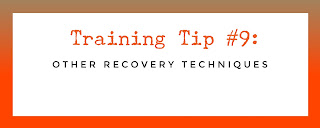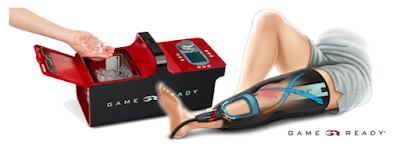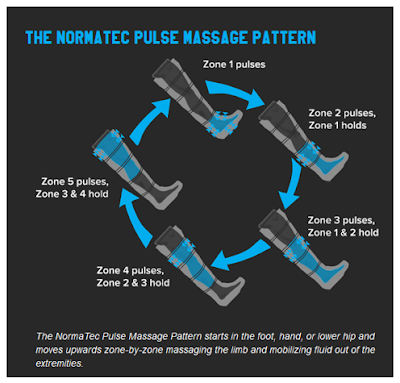completed my first 2 half marathons. I
was cruising through my first half back in June and I remember saying to myself
at mile 10, “Wow, I can’t believe how great I feel!” Then I got to mile 11 and my left calf
started to cramp, shortly followed by my right calf. No matter how much stretching I did on the
course, I could not stop the cramping.
It wasn’t pretty but I finished the race, limping across the finish line. I remember the pain being severe over the
next few days at work but this didn’t stop me from registering for another
half marathon in the fall.
with my training, I decided to try wearing compression sleeves over my
calves. There isn’t much evidence out
there supporting that they’ll improve performance, but there is some evidence
stating that they prevent muscle soreness post longer runs. I wore these sleeves during my second half
marathon last year and I got through the entire race without cramping and
without excessive soreness afterwards either.
with an injury you always want to remember the acronym P.R.I.C.E.
 |
| Paula Radcliffe sporting compression as she sets the World Record at the 2003 London Marathon! |
exercise muscles produce lactic acid.
Too much lactic acid causes muscle soreness and also makes muscles
fatigue quicker leaving them susceptible to injury. Wearing compression socks helps fight the
effect of gravity and can help return blood to the heart quicker. This allows the body to eliminate lactic acid
more efficiently allowing our muscles to perform better over the course of a
long run. In theory this sounds great!
My calves definitely felt the difference in a good way. But do they actually work?
Bachand, MSc PT, BSc Kin who does an excellent job summarizing the current
evidence on this topic. Basically most
studies do not correlate wearing compression socks to improved running
performance or improvements in physiological performance such as HR, blood
lactate levels, or VO2 max profiles.
However, one study from the International Journal of Sports Medicine by
Bringard et al back in 2006 showed that wearing compression tights decreased
running energy costs but only at very low speeds.[i] So the compression socks/sleeves may provide
a benefit for those like me who run at 9-10 minutes/mile or slower paces. You can check out Andrea’s article here: https://www.run3d.co.uk/announcements/compression_socks.
beneficial after an injury. It is a
natural anti-inflammatory. Sometimes the
body over compensates for an injury and swelling can become excessive. Ice helps reduce swelling immediately after
an injury. However, when swelling is
already present, that’s where combining ice with compression can help even
more.
a company that provides Active Cold Compression Therapy. A sleeve is wrapped around the injured body
part which circulates ice water and inflates to aid in the healing process. Cold therapy is effective because it slows
the metabolic demand of cells, which limits the cells need for oxygen,
preventing secondary tissue damage. The
unit then inflates adding compression to the desired body part. This produces a pumping action, mimicking
what our muscles do. This muscle pumping-like action helps eliminate swelling
from the area, aiding in lymphatic drainage and improving blood flow. [ii]
company that provides dynamic compression is NormaTec and has become very
popular among professional athletes.
NormaTec makes dynamic compression devices that use a Pulse Massage
Pattern to help improve lymphatic drainage, thus improving blood flow. There have been several studies published
demonstrating the benefits of dynamic compression. There are 3 components to NormaTec’s patented
Pulse Massage Pattern. Pulsing is the first component. This is more effective than static
compression because it mimics the muscle pumping action of our arms and legs,
“greatly enhancing the movement of fluid and metabolites out of the limbs after
an intense workout.”[iii] NormaTec also utilizes gradients to mimic the
one way valves in our veins and lymph vessels.
These valves prevent fluid backflow.
NormaTec uses hold pressures in separate zones to keep fluids from being
forced in the wrong direction, allowing the device to deliver maximum pressure
in each zone.[iv] NormaTec than utilizes a distal release
pattern, releasing the hold pressures in lower (or distal) zones once they are
no longer needed to prevent backflow.[v] There are 7 levels of pressure. I feel most comfortable at level 5.
video below to listen to Celtics Head Athletic Trainer, Ed Lacerte, explain the
benefits of NormaTec![vi] (I love Waltah!)
using the NormaTec sleeves as part of my recovery from a recent hamstring/calf
injury. It feels great after a 15-minute
treatment and really helps accelerate the recovery process.
just a few things that can help speed your recovery after a long run or help
accelerate the healing process after an injury.
Let’s face it, us runners hate to take time off from running!
About
Jon Carroll PT DPT OCS
Jon joins the Cape Cod Rehab Running
Team with a few personal running accomplishments including finishing his first
2 half marathons in 2015. A three sport
athlete in high school, Jon took up running after completing his first Falmouth
Road Race back in 2010 and hasn’t looked back.
A Physical Therapist and Orthopedic Clinical Specialist (OCS), Jon
enjoys working with runners because he knows how good running feels and
understands the frustration when runners have to take a break when
injured. Jon’s goal is to run a full
marathon in the near future. His motto:
“Ultimate fitness is a marathon, not a sprint.”
https://www.normatecrecovery.com/how-compression-works/how-and-science/default.aspx#sci
https://www.normatecrecovery.com/how-compression-works/how-and-science/default.aspx#sci




